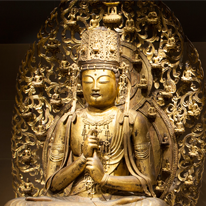Past Exhibitions
- Buddhist Sculpture of the Jōchō Style and the Kei School
- June 14, 2016 - July 24, 2016
The style in which Buddhist sculptures were carved changed over time. In the late Heian period (11th–12th century), in keeping with the tastes of the court and the aristocratic Fujiwara clan regents, there was a trend for sculptures with gentle expressions and shallow carving. The flag bearer of this style the master sculptor Jōchō (died 1057), best known for his large Seated Amitabha (J: Amida) in the Phoenix Hall of Byōdō-in Temple in Uji, south of Kyoto. What came to be known as the “Jōchō style” dominated the world of Buddhist sculpture for over a century to follow. With the advent of the Kamakura period (1185–1333), however, tastes changed. The new shogunate and other warrior-class patrons preferred a more realistic, dynamic style that was best represented by sculptors of the Kei school, such as Unkei (died 1224). The works on view here represent these two different styles, both innovations of their age.












